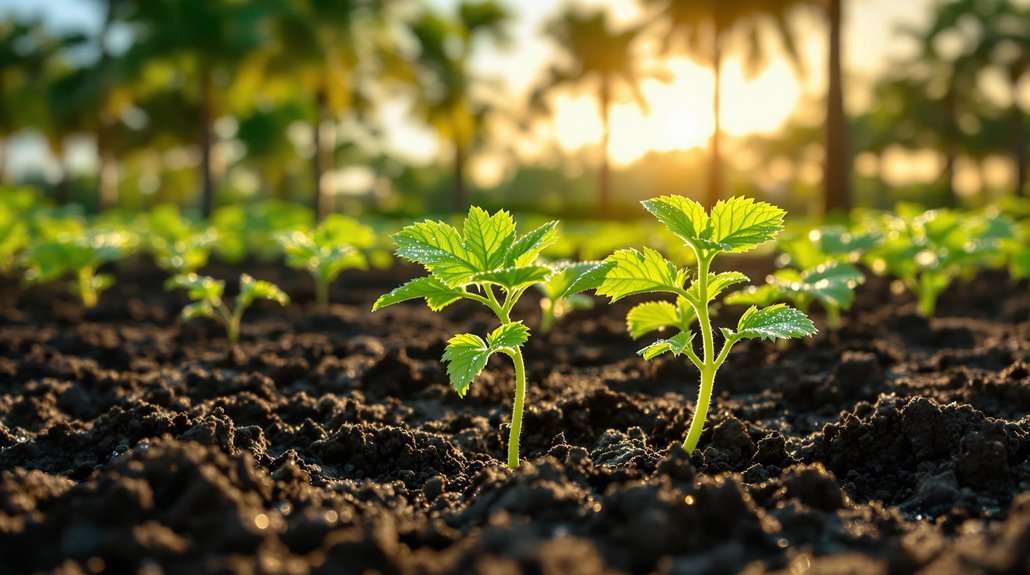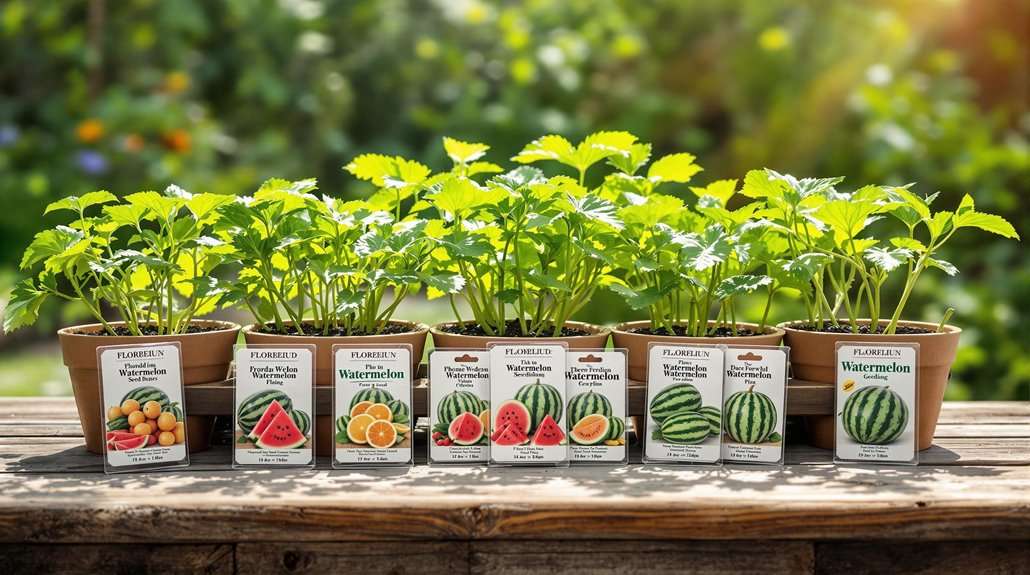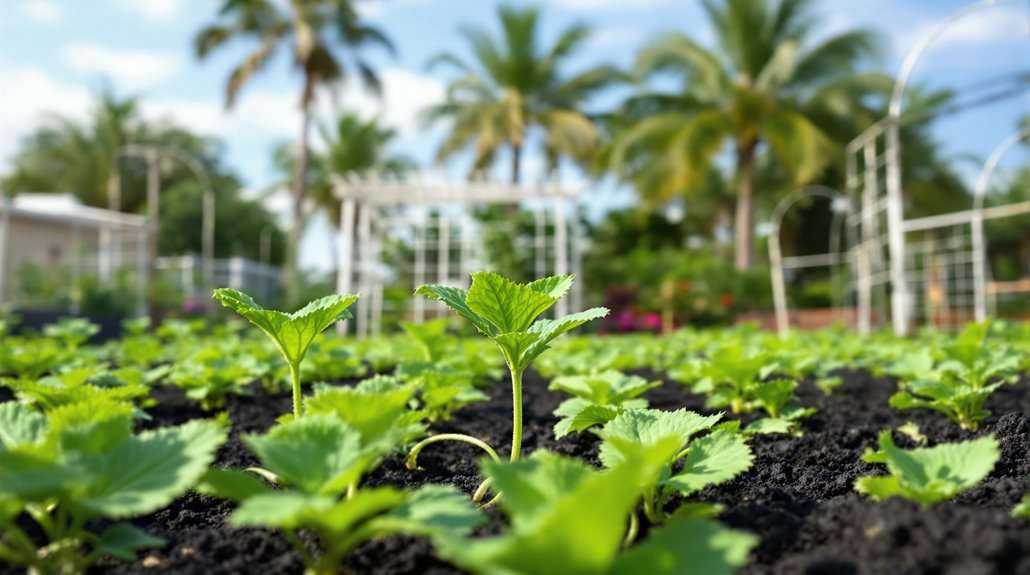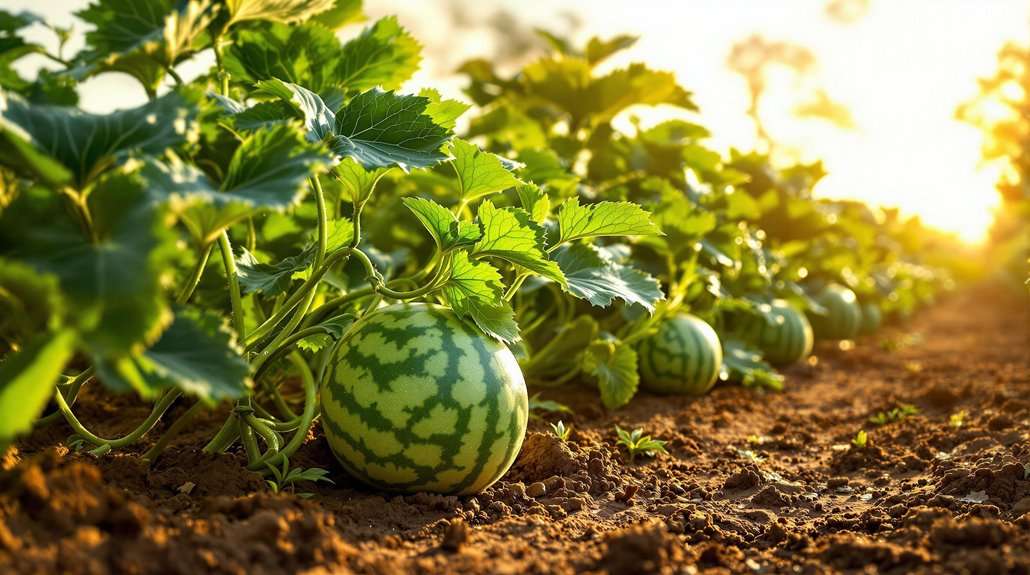When to Plant Watermelon in Florida
You'll need to time your watermelon planting carefully in Florida based on your specific region. In South Florida, plant between December 15 and March 1, while Central Florida's ideal window is January 15 to March 15. If you're in North Florida, wait until February 15 to April 15 when soil temperatures consistently reach above 70°F. Success depends on selecting varieties suited to your area, preparing well-draining soil with pH between 6.0-6.8, and spacing plants 36-48 inches apart on mounds. These hardy vines take 80-100 days to mature, so proper timing aligns with warm, stable weather patterns for the sweetest harvest potential.
This post may contain affiliate links. If you make a purchase through these links, I may earn a commission at no additional cost to you. Additionally, portions of this post may be generated using artificial intelligence (AI) technology. While we strive for accuracy, please be aware that AI-generated content may not always be perfect and should be fact-checked when necessary.
The Spatula Scoops
- South Florida gardeners should plant watermelon between December 15 and March 1 to manage humidity and warmer temperatures effectively.
- Central Florida's optimal planting window falls between January 15 and March 15 when soil temperatures become suitable.
- North Florida growers should plant watermelon from February 15 to April 15, watching for late frost risks.
- Soil temperature must consistently remain above 70°F for successful germination and growth of watermelon plants.
- Watermelons take 80-100 days to mature, so timing should align with warm, stable weather throughout the growing season.
Best Planting Times By Region

Across Florida's three main regions, ideal watermelon planting times vary considerably due to differences in climate and frost patterns. You'll need to carefully time your planting based on your specific location to guarantee optimal growth and harvest success. Creating well-drained mounds with organic matter will improve both drainage and nutrient retention for your watermelon plants.
In South Florida, you can start planting as early as December 15 and continue through March 1, taking advantage of the region's warmer winter temperatures. If you're in Central Florida, your planting window begins slightly later, from January 15 to March 15, when soil temperatures have warmed sufficiently for successful germination. North Florida gardeners should wait until February 15 to April 15, paying close attention to local frost dates, particularly around Jacksonville where the last frost typically occurs around March 15.
You'll want to think about using either seeds or transplants, though you'll need to handle transplants with extra care due to their sensitive root systems. For all regions, confirm your soil temperature stays consistently above 70°F and provide full sun exposure. Remember that you're looking at 80-100 days until harvest, so timing your planting to align with warm, stable weather conditions is vital for success.
Ideal Growing Conditions
Four key conditions must align for successful watermelon growth in Florida: proper soil composition, ideal weather patterns, adequate spacing, and consistent watering.
You'll need well-draining soil enriched with calcium and lime to prevent blossom-end rot, a common issue in Florida's climate. While watermelons aren't picky about soil type, adding fertilizer or compost during planting will boost their nutrition. Pale yellow flowers will bloom as your vines develop. Your plants will thrive in temperatures between 70-85 degrees with full sun exposure, which Florida typically provides in abundance.
Space management is essential for your watermelon patch. Each plant requires 18-24 square feet to spread out, so you'll want to space your mounds 6 feet apart in all directions. This spacing allows proper air circulation and helps prevent disease spread. In Florida's humid conditions, keeping fruits elevated off damp soil can prevent rotting.
Your watering schedule should adapt as plants mature. Water daily when plants are young, then reduce to twice weekly as they establish themselves. Don't overwater, as this can dilute the fruit's sweetness. Remember to monitor consistently for pests and diseases, which are common in Florida's warm climate.
Choosing Your Watermelon Variety

When you're ready to choose your watermelon variety in Florida, you'll find both seeded options like the Florida Giant, which thrives in the state's warm climate, and seedless hybrids that are gaining popularity among home gardeners. Your location within Florida matters, as northern counties might benefit from shorter-season varieties like Sugar Baby, while central and southern regions can successfully grow longer-maturing varieties such as Charleston Grey. The Florida Giant remains a reliable choice throughout the state, producing substantial fruits with dark green rinds and sweet, red flesh within 80-90 days of planting. With proper planting techniques, gardeners should sow seeds 6 inches apart to ensure optimal growth and fruit development.
Popular Florida Varieties
Florida gardeners have several excellent watermelon varieties to choose from, each offering unique characteristics that suit different growing spaces and preferences. If you're looking for a compact option, Sugar Baby's bush-type growth makes it perfect for smaller gardens while still delivering sweet, juicy melons. For those seeking high yields, Mickeylee produces abundant icebox-sized fruits with exceptional flavor. Many growers time their plantings to ensure their crops are ready for Memorial Day sales.
- Jubilee (Florida Giant) delivers large melons with high sugar content, making it ideal for those who want substantial harvests
- Crimson Sweet features a distinctive yellow-green rind and deep red flesh, perfect for traditional watermelon enthusiasts
- Charleston Grey 133 produces elongated melons with thick, grey rinds that protect the sweet interior
- Sugar Baby's compact size allows for efficient use of garden space while maintaining excellent flavor
When selecting your variety, consider your available space, as most watermelons need 18-24 square feet per plant. Each variety takes between 80-100 days to mature, so plan your planting schedule accordingly. Remember that all these varieties thrive in Florida's well-drained, sandy soils and warm temperatures, particularly when supported by proper irrigation and pollination.
Seeded vs. Seedless Options
Most Florida gardeners face an important decision between seeded and seedless watermelon varieties, each offering distinct advantages for home cultivation. If you're considering seeded varieties, you'll find they're generally more adaptable to Florida's diverse growing conditions and often provide better flavor, though you'll need to account for seed removal during consumption. The warm, humid climate of Florida provides excellent growing conditions for both types of watermelons, making the choice primarily about personal preference rather than environmental limitations.
Seedless varieties offer convenience and consistency, but you'll need to pay closer attention to growing conditions and may face higher initial costs. While both types require similar growing periods of 80-100 days, seeded watermelons tend to be more resilient and allow you to save seeds for future seasons. They're also less demanding when it comes to specific temperature and moisture requirements.
If you're growing commercially or prefer uniform fruits, seedless varieties might be your better choice despite their higher maintenance needs. You'll find they typically produce more consistent yields when properly managed. However, if you're a home gardener looking for maximum flexibility and lower startup costs, seeded varieties offer proven reliability and adaptability to Florida's growing conditions.
Best Varieties Per Region
Choosing the right watermelon variety for your region greatly impacts your growing success in Florida's diverse climate zones. South Florida growers often opt for 'Sugar Baby' and 'Mickeylee' for smaller, icebox-sized melons, while 'Jubilee' and 'Charleston Grey 133' excel for larger fruit production. In Central Florida, you'll find 'Crimson Sweet' and 'Jubilee' performing exceptionally well, particularly due to their disease resistance in humid conditions. For optimal growth conditions, maintain temperatures between 70°F to 85°F during the growing season.
- North Florida growers can capitalize on longer growing seasons with varieties like 'Charleston Grey 133' and 'Jubilee'
- South Florida's early planting window (December 15 to March 1) works best with quick-maturing varieties
- Central Florida's growing conditions favor disease-resistant varieties that can handle varying soil conditions
- Consider your market demands when selecting between icebox-sized or traditional large melons
When you're selecting your variety, you'll need to account for your specific region's challenges. In South Florida, you're dealing with intense humidity, while North Florida growers must protect against occasional cold fronts. Central Florida growers should focus on varieties that can withstand seasonal temperature fluctuations while maintaining consistent fruit quality.
Preparing The Soil
Successful watermelon growing starts with proper soil preparation, and you'll need well-drained, nutrient-rich soil for the best results. In Florida, sandy soils work particularly well, especially in areas with heavy rainfall, as they provide excellent drainage and prevent root rot issues that can plague your plants. Three-month growth cycles make soil quality especially critical for timely harvests.
You'll want to maintain a soil pH between 6.0 and 6.8, which you can verify through regular soil testing. Before planting, incorporate balanced fertilizers focusing on nitrogen, phosphorus, potassium, and calcium. Adding lime helps prevent blossom-end rot, while compost enriches the soil's organic matter content.
To protect your watermelon patch, create drainage ditches to prevent water pooling, and consider planting windbreaks like rye or sorghum to shield young plants. You'll also want to turn and aerate the soil thoroughly before planting. Don't forget to lay down cardboard or mulch to keep your developing melons off wet ground.
Remember to implement crop rotation practices to maintain soil health and reduce disease pressure. Managing weeds is essential, as they'll compete with your watermelons for nutrients and water, potentially reducing your harvest yield.
Planting And Spacing Guidelines

To maximize your watermelon harvest in Florida, you'll need to carefully time your planting and maintain proper spacing between plants. Your planting timeline will vary depending on your location, with South Florida starting as early as December 15, Central Florida in mid-January, and North Florida waiting until mid-February. Before planting, ensure your soil is enriched with aged organic matter and compost for optimal nutrient availability.
- Create mounds approximately 6 feet apart in all directions to give your vines adequate growing space
- Space individual plants 36-48 inches apart within rows, maintaining 6-8 feet between rows
- Allow 18-24 square feet of growing space per plant to accommodate spreading vines
- Place cardboard or straw beneath developing fruits to prevent ground contact and rotting
When you're ready to plant, make certain you're starting after the last frost date in your region. You'll want to prepare your planting area with plastic mulch to warm the soil and floating row covers to protect young plants. For the best growth, maintain consistent moisture using soaker hoses or drip irrigation systems. Don't forget to take into account your harvest accessibility when planning your layout – you'll need clear paths between rows to check ripeness and collect mature melons throughout the growing season.
Seasonal Care Requirements
Four key elements drive successful watermelon growth in Florida's unique climate: proper watering, balanced fertilization, pest management, and adequate sunlight.
You'll need to maintain soil temperatures of at least 70°F and provide 1-2 inches of water weekly through a drip irrigation system. During Florida's intense heat, it's vital that you don't overwater, as this can lead to rot, but guarantee consistent moisture for ideal fruit development. Your watermelons will thrive with a balanced, slow-release fertilizer supplemented by compost or manure. Popular Florida varieties like Crimson Sweet and Sugar Baby are well-suited to the state's humid conditions.
To protect your crop, you'll want to monitor regularly for blossom-end rot and create proper drainage to keep melons off wet soil. During flowering, avoid pesticides to protect essential pollinators. Remove damaged leaves promptly, and don't forget to trim suckers and side shoots from the main vine.
Position your watermelon patch where it'll receive 6-8 hours of full sun daily, and give vines plenty of room to spread their potential 10-foot reach. You can use straw beds to keep developing fruits off the ground, and you'll need to train vines regularly for proper spacing and growth.
Harvest Time Planning

After nurturing your watermelon plants through their growth cycle, knowing the right time to harvest makes all the difference in flavor and quality. You'll need to monitor several key indicators during the 80-100 day maturation period, paying close attention to changes in the final two weeks before harvest. For optimal growth and development, maintain temperatures between 70 to 85 degrees during the day.
To confirm you're harvesting at peak ripeness, watch for these essential signs:
- The rind will shift from a bright, glossy green to a duller shade
- The bottom spot where the melon touches the ground will change from white to creamy yellow
- The tendril closest to the fruit's stem will become brown and dry
- When thumped, the melon will produce a deep, hollow sound
You'll want to reduce watering about a week before your planned harvest to concentrate the sugars in the fruit. Once harvested, you can store uncut watermelons for up to 10 days in a cool, dry place. Plan your harvesting schedule carefully, considering Florida's climate patterns and choosing varieties that align with your intended growing season, whether it's the winter or summer production period.
Frequently Asked Questions
How Many Watermelons Typically Grow on One Plant in Florida?
Imagine you're checking your 'Crimson Sweet' watermelon plant and spot three plump melons developing. You'll typically get 2-3 watermelons per healthy plant in Florida, though this can vary. Your yield depends on your variety choice, growing conditions, and care practices. Small varieties like 'Sugar Baby' might give you 3-4 fruits, while larger types like 'Jubilee' often produce 1-2 substantial melons per plant.
Can You Grow Watermelons in Containers on Florida Patios?
You can definitely grow watermelons in containers on your Florida patio, but you'll need large containers with at least 18-24 square feet of space and 12-14 inches of depth. Make certain your container has good drainage and use rich, well-draining potting soil. You'll need to provide sturdy support for the vines, guarantee full sun exposure, and maintain consistent moisture. Consider bush varieties for smaller spaces.
Do Florida Watermelons Cross-Pollinate With Other Cucurbit Plants in the Garden?
Yes, your Florida watermelons will dance with other cucurbit relatives in your garden through cross-pollination. While this natural process won't affect your current season's fruit quality, it'll impact any seeds you're planning to save. If you're growing multiple cucurbit varieties, like cucumbers or pumpkins, they can cross-pollinate when bees visit their flowers. For pure seed saving, you'll need to keep varieties separated by at least 500 feet or use physical barriers.
How Long Can Watermelon Vines Remain Productive in Florida's Climate?
In Florida's climate, your watermelon vines will typically remain productive for 80 to 100 days after planting. You'll get the best production during the peak season from May 1 to July 1, though harvesting can extend from April through mid-July. You'll need to maintain consistent watering and fertilization throughout this period. Keep in mind that high humidity and excessive rainfall can shorten your vine's productive lifespan by promoting disease.
Should You Rotate Watermelon Planting Locations Each Growing Season?
You'll absolutely want to rotate your watermelon planting locations each season – it's just like giving your garden a fresh start. This practice greatly reduces soil-borne diseases, prevents pest buildup, and maintains soil fertility. By implementing a 3-4 year rotation cycle, you're not only breaking disease cycles but also improving your overall yield. Remember, keeping watermelons in the same spot can deplete specific nutrients and encourage persistent pest problems.





